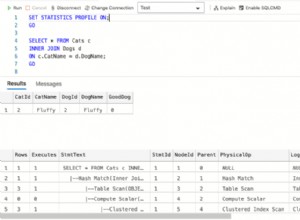Използвайте това, за да прочетете файла в байтов масив:
// Old fashioned way
public static byte[] ReadFile(string filePath)
{
byte[] buffer;
FileStream fileStream = new FileStream(filePath, FileMode.Open, FileAccess.Read);
try
{
int length = (int)fileStream.Length; // get file length
buffer = new byte[length]; // create buffer
int count; // actual number of bytes read
int sum = 0; // total number of bytes read
// read until Read method returns 0 (end of the stream has been reached)
while ((count = fileStream.Read(buffer, sum, length - sum)) > 0)
sum += count; // sum is a buffer offset for next reading
}
finally
{
fileStream.Close();
}
return buffer;
}
или
// Thanks Magnus!
byte[] data = System.IO.File.ReadAllBytes(filePath);
След това запазете данните за изображението, като използвате това (използвам клас на изображение "екземпляр", който съдържа информация за моето изображение и масив от байтове в instance.Data):
using(SqlCommand cm = new SqlCommand("SaveImage", connection, transaction)){
cm.CommandType = CommandType.StoredProcedure;
cm.Parameters.Add(new SqlParameter("@Id", SqlDbType.Int,0, ParameterDirection.InputOutput, false, 10, 0, "Id", DataRowVersion.Current, (SqlInt32)instance.Id));
cm.Parameters.Add(new SqlParameter("@Title", SqlDbType.NVarChar,50, ParameterDirection.Input, false, 0, 0, "Title", DataRowVersion.Current, (SqlString)instance.Title));
if (instance.Data.Length > 0)
{
cm.Parameters.Add(new SqlParameter("@Data", SqlDbType.VarBinary,instance.Data.Length, ParameterDirection.Input, false, 0, 0, "Data", DataRowVersion.Current, (SqlBinary)instance.Data));
}
else
{
cm.Parameters.Add(new SqlParameter("@Data", SqlDbType.VarBinary,0, ParameterDirection.Input, false, 0, 0, "Data", DataRowVersion.Current, DBNull.Value));
}
cm.ExecuteNonQuery();
)
А ето и примерна съхранена процедура:
CREATE PROCEDURE SaveImage
(
@Id int OUTPUT
,@Title nvarchar(50)
,@Data varbinary(MAX)
)
AS
SET NOCOUNT ON
SET XACT_ABORT ON
IF @Id IS NULL OR @Id <= 0
BEGIN
SELECT @Id = ISNULL(MAX([Id]),0) + 1 FROM [dbo].[Images]
END
INSERT INTO [dbo].[Images] (
[Id]
,[Title]
,[Data]
) VALUES (
@Id
,@Title
,@Data
)




